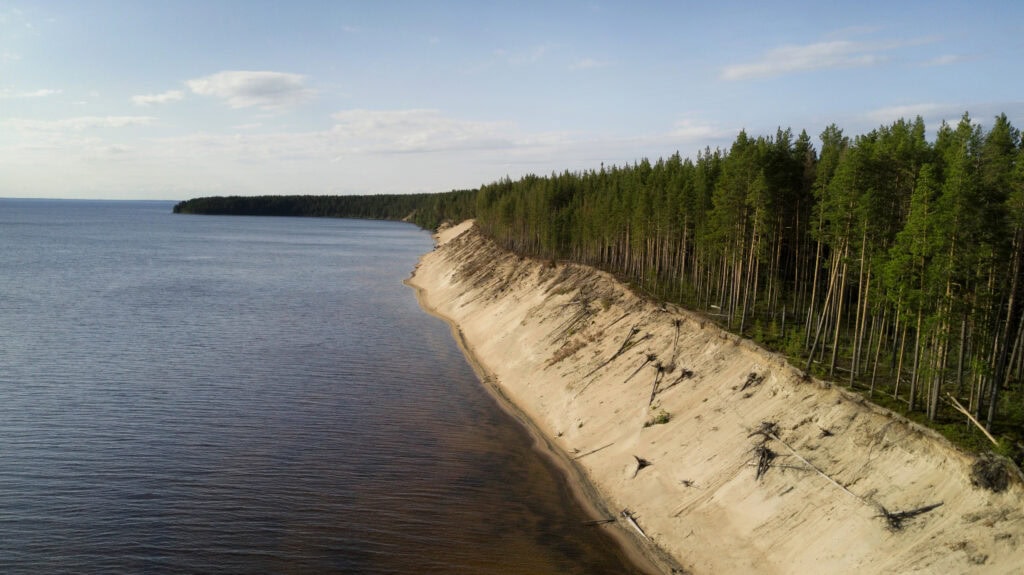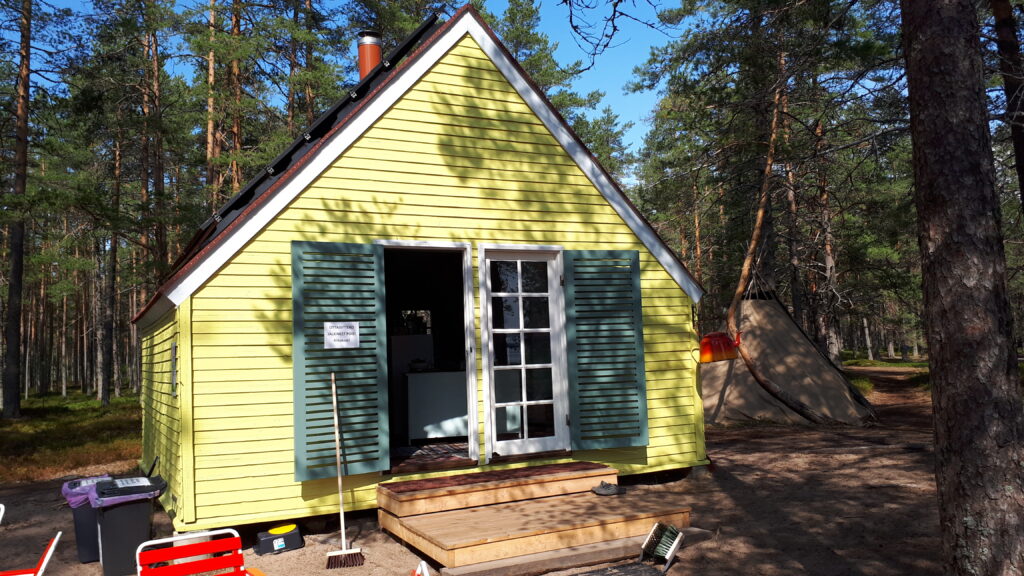When recounting the history of Ärjänsaari Island, one cannot help but marvel at the effects of the Ice Age, the sacrificial rituals of the ancient Lapps, the burning of tar pits, and the summer celebrations of thousands of vacationers. Ärjä has served in many different ways!
Fortunately, Ärjä Island is currently managed by Metsähallitus Natural Heritage Services, whose goal is to preserve the island’s atmosphere and make it a delightful destination for both summer and winter vacationers. Before this, however, many things happened on Ärjä Island.
The island’s history dates back to between 1300 and 1400. At that time, Ärjä separated from Kumpuniemi due to rising water levels and became an island in its own right. Until then, Ärjä had been part of a continuous ridge area; the sand ridges on the island are part of a long ridge that runs from Hailuoto through Sotkamo to Ilomantsi. The ridges were formed by a glacial river that melted during the Ice Age.
The gathering place of ancient deer hunters
Several pieces of evidence have been found on Ärjäsaari indicating that the Lapps settled there around a thousand years ago. Ärjä was an important gathering place for reindeer hunters, who gathered there every year to perform sacrificial rituals to ensure a good reindeer harvest for the coming year.
Stories and legends tell that the Lapps had a Poronkirkko (reindeer church) and Aarretörmä (treasure hill) on the island, where a gold treasure is buried. The exact location of neither has been determined.

In the 19th century, Ärjä was known for its bandits and tar pits.
In the mid-19th century, the inhabitants of local villages were tormented by the notorious Kives robbers, who stole meat, grain, and tar. The Kives robbers lived on Ärjänsaari Island, so fishermen and passing boaters were advised to steer clear of the island at that time.
After the Great Partition in 1897, Kalle Karjalainen, a farmer from Sivolanniemi, bought Ärjänsaari for a thousand marks. Karjalainen burned tar on the island. After running into financial difficulties, he was forced to sell the island to pay off his debts at the turn of the century. The sale price was 3,000 marks, and the new owner was Otto Ravander, a tar distiller from Oulu.
As a reminder of the tar pits, their bottoms can still be found on the island today!
The 20th century brought logging, sand transport, and holiday resorts.
Ravanden decided to carry out large-scale logging on the island in the early 20th century. However, in 1916, the island changed hands when Kajaanin Puutavara Oy acquired it for 65,000 marks. At that time, sand began to be transported from the island by barge for use in brick manufacturing.
The same sand barges were later used to transport holidaymakers when Ärjä became a summer resort for the company’s employees in the 1930s. Later, the barges were put to other uses: one was converted into the Säippä pier on Ärjänsaari in the 1950s, and the other into a breakwater. The remains of the barges can still be seen: Säippä’s old pier lies in the shallow water, providing an intriguing snorkeling and diving site as well as a shelter for fish.
With the arrival of holidaymakers, six steep-roofed beach cottages designed by Eino Pitkänen were built on the island in 1937. One of these cottages still serves as a summer café in Ärjä today!

As the number of holidaymakers grew, Kajaanin Puutavaraosakeyhtiö built more holiday cottages for its employees in the late 1940s. The island also quickly needed a guesthouse, a dining hall, a smoke sauna, and a caretaker’s apartment. A caretaker was on duty on the island year-round until the 1990s! In the 1950s, Ärjä became a lively summer vacation island, which is still remembered fondly by the people of Kajaani with stories and pleasant vacation memories.
The enthusiasm of holidaymakers waned in the 1990s.
At the end of the 1980s, Kajaani Oy, which owned the island, merged with Yhtyneet Paperitehtaat, and from 1996 onwards, the company was known as UPM-Kymmene. People’s vacation habits began to change; foreign countries and private cottages attracted Finns, and the island was no longer maintained for staff vacations as it had been in the past. The island’s buildings and activities slowly began to fall into disrepair.
In the memories of the people of Kainuu, Ärjä’s golden age was the 1950s, when on a beautiful weekend there could be over 1,000 summer visitors on the island. For children, Ärjä was like an amusement park with its water slides and games, while for adults it was a holiday paradise where they could escape from their everyday lives for a while.
However, the joyful holidays on the island are not over yet; efforts are once again being made to improve the comfort of Ärjä.
A new golden age has begun
After a period of silence, Ärjänsaari has once again begun to flourish. When the island was transferred to the management of Metsähallitus Natural Heritage Services in 2017, things began to happen. The island’s shores are part of the Natura 2000 protected area, and the entire island has been nominated as a nature reserve.
The development plan drawn up by Metsähallitus outlines that the island’s cottages will be renovated and the island’s unique atmosphere will be preserved. In 2019, the first sheepherders and their sheep arrived on the island, and the summer of 2020 was already a delightfully busy time in terms of boat transport.
Finns have clearly embraced Ärjä once again. You too are warmly welcome to explore the island’s secrets. Respect the island and its nature during your visit, and the island will treat you well. 🙂
